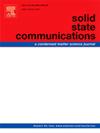Modification in the structural and dielectric properties of ErCrO3 on Fe substitution
IF 2.4
4区 物理与天体物理
Q3 PHYSICS, CONDENSED MATTER
引用次数: 0
Abstract
Polycrystalline samples of ErCr1-xFexO3 (0≤ x ≤ 0.30) have been synthesized in single-phase form using the sol-gel technique. XRD patterns analyzed via Rietveld refinement confirm the orthorhombic structure with unit cell volumes increasing from 216.989 Å3 (x = 0.00) to 218.565 Å3 (x = 0.30), attributed to the substitution of larger Fe3+ ions (0.645 Å) for Cr3+ ions (0.615 Å). Scanning Electron Microscopy (SEM) showed grain sizes ranging from 335 nm (x = 0.00) to 689 nm (x = 0.15). Energy Dispersive X-ray Spectroscopy (EDX) and Raman Spectroscopy corroborated the formation of the orthochromite structure. Impedance spectroscopy study revealed a discontinuity in the resistive behavior for all the samples showing the appearance of positive temperature coefficient of resistance (positive TCR) like transition in the temperature range of 393 K–443 K. Similar trend was also observed in the dielectric and the conductivity measurements around the same temperature range. All the ErCr1-xFexO3 compounds showed a colossal dielectric constant value (>104) at room temperature, supporting the potential use of these compounds in electronic devices. The ac conductivity spectra followed Jonscher Power Law (JPL).

铁取代对ErCrO3结构和介电性能的影响
采用溶胶-凝胶技术以单相形式合成了ErCr1-xFexO3(0≤x≤0.30)多晶样品。通过Rietveld细化分析的XRD谱图证实了正交结构,单位胞体积从216.989 Å3 (x = 0.00)增加到218.565 Å3 (x = 0.30),这是由于较大的Fe3+离子(0.645 Å)取代了Cr3+离子(0.615 Å)。扫描电镜(SEM)显示晶粒尺寸在335 nm (x = 0.00) ~ 689 nm (x = 0.15)之间。能量色散x射线光谱(EDX)和拉曼光谱证实了正铬铁矿结构的形成。阻抗谱研究表明,在393 K - 443 K温度范围内,所有样品的电阻行为都呈不连续现象,表现为正的电阻温度系数(正TCR)样转变。在相同温度范围内的介电和电导率测量中也观察到类似的趋势。所有的ErCr1-xFexO3化合物在室温下都显示出巨大的介电常数值(>104),支持这些化合物在电子器件中的潜在用途。交流电导率谱符合Jonscher幂律(JPL)。
本文章由计算机程序翻译,如有差异,请以英文原文为准。
求助全文
约1分钟内获得全文
求助全文
来源期刊

Solid State Communications
物理-物理:凝聚态物理
CiteScore
3.40
自引率
4.80%
发文量
287
审稿时长
51 days
期刊介绍:
Solid State Communications is an international medium for the publication of short communications and original research articles on significant developments in condensed matter science, giving scientists immediate access to important, recently completed work. The journal publishes original experimental and theoretical research on the physical and chemical properties of solids and other condensed systems and also on their preparation. The submission of manuscripts reporting research on the basic physics of materials science and devices, as well as of state-of-the-art microstructures and nanostructures, is encouraged.
A coherent quantitative treatment emphasizing new physics is expected rather than a simple accumulation of experimental data. Consistent with these aims, the short communications should be kept concise and short, usually not longer than six printed pages. The number of figures and tables should also be kept to a minimum. Solid State Communications now also welcomes original research articles without length restrictions.
The Fast-Track section of Solid State Communications is the venue for very rapid publication of short communications on significant developments in condensed matter science. The goal is to offer the broad condensed matter community quick and immediate access to publish recently completed papers in research areas that are rapidly evolving and in which there are developments with great potential impact.
 求助内容:
求助内容: 应助结果提醒方式:
应助结果提醒方式:


